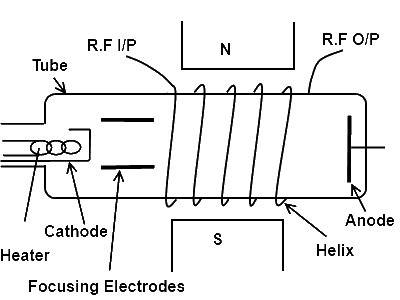Travelling Wave Tube (TWT)
The Traveling-wave tube can be used as a medium or high power microwave, amplifier. The TWT, because of its construction and working principle has enormous bandwidths and low noise. The heated cathode at one end of the tube produces a beam of electrons and is attracted to the collector at the other end of the tube. The input signal is fed at one end of the tube and an amplified version of the input signal is taken from the other end.
Construction

As shown in the figure. The TWT consists of a glass tube or envelope in which heater, cathode, frequency electrons and anode are located. A conducting wire is wrapped around the glass envelope to which I/P and O/P are connected. A permanent magnet is also kept around the envelope over the helix or conducting spring focusing electrodes are used to keep the electrons beam right in the center. The permanent magnet is used to produce the slow speed of electrons. The wire given the shape of spring in order to slow down the speed of electrons emitted from cathode.
Working of TWT
When we switch on the circuit the cathode starts the emission of electrons. The focusing electrodes focus these electrons in a narrow beam at the center of tube. These electrons travel toward the anode and if no signal is applied at the helix then the emitted electrons will be collected by the anode without any obstruction.
When the R.F signal is applied at the input of the helix, the positive half cycle will accelerate the speed of electrons emitted by the cathode and negative cycle will de accelerate the speed of electrons emitted by the cathode. As a result the electrons will be found in bunches and it will travel towards the anode within the helix. The volume of bunch will become stronger and stronger as the electrons approaches towards the anode end.
Therefore, at the output end of the helix, there will be a strong electric field created by the buncher which will result to produce the amplified output signal.
The magnet is used around the helix in order to produce the strong magnetic field which causes the electron beam to remain in the center. The helix is used a slow structure because if from input to output we use a straight wire, then the speed of electrons through the straight will be more w.r.t speed of electrons emitted from cathode hence, no amplification will take place.
In case of helix, the speed of electrons moving in the helix is synchronized with the speed of electrons emitted by the cathode, therefore, this system is known as slow wave structure.
